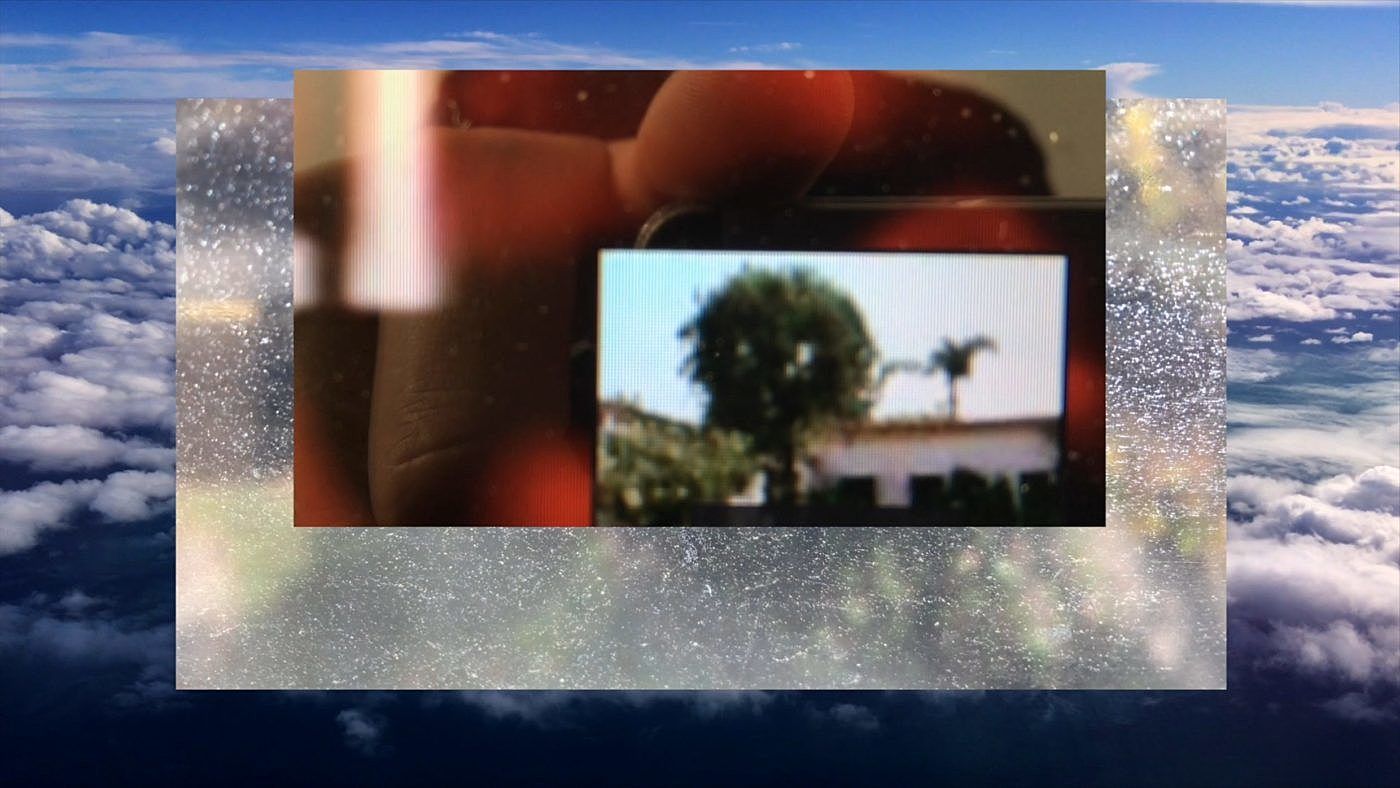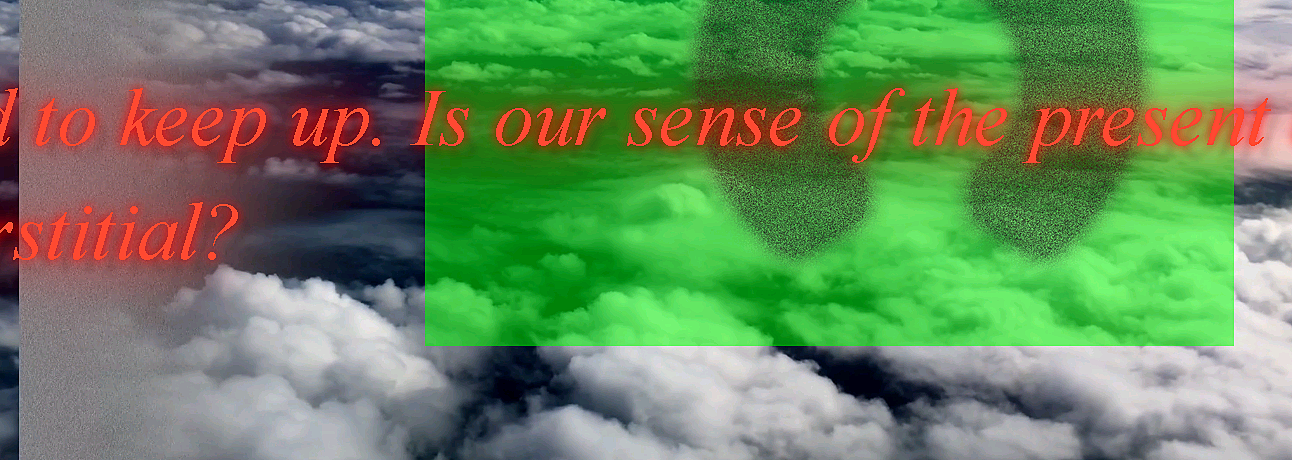Reality Is Already Augmented: William Linscott's 'XCIII'
Eloise Callister-Baker on William Linscott's new work at Michael Lett.
William Linscott’s video work is the latest in a procession of practices that trade in the visual and linguistic aesthetics of the internet age. But Eloise Callister-Baker finds that its depths go further than the kitsch of other efforts.
It is all too easy to get lost in the spectacle. Where, in all of this, can we find the long white cloud, its lands, and most importantly; the people, the people, the people?
XCIII may remind an older generation of the digital world they have built up around them – for anyone younger, we have not experienced a ‘before’ to compare to its messy ‘after’. While XCIII converses fluently and eagerly with its younger audience, those who still remember life before our modern, networked society may feel more complicated about the dialogue it tries to strike up. Art that both immerses itself and critically enquires into thia digital world often puts the last of us to know that liminal state between pre and post-internet a bit on edge.
William Linscott made XCIII for his Masters in Fine Arts, which he completed last year at Elam School of Fine Arts. Throughout March, the seventeen-and-a-half minute video-work showed in the bank vault downstairs at Michael Lett Gallery in an exhibition titled under the shadow of the cloud. The exhibition ran in conjunction with a selection of et al’s work from 2003 to 2008. In a well-calculated move, a related work by Linscott, beyond the shadow of the cloud, appeared on Window Gallery’s online exhibition space around the same time. This second show is a crucial companion text to the first.
XCIII is divided into three chapters. Each chapter is distinguished by its title and colours: red, green and blue. These are, of course, the three additive primary colours used for the display of images in televisions and computers. The structure of each chapter is also affirmed by audio-breaks or shifts -a white-noise crescendo, or near silence (The two-channel soundtrack throughout, which is vital to the work’s impact, was made by Flinn Gendall).
The work begins with a montage of familiar starting points: the title of the work; a loading bar; the text box that appears when opening a new document on Photoshop. This montage cuts to a list of the work’s properties in a desktop note-app. There is no voiceover to anchor the meaning of the images in this montage; there doesn’t need to be. Linscott assumes his audience is steeped in the digital and fluent in its language; and, thus, the conversation begins.
The first chapter is titled “To What End”. Its colour is revealed in a subsequent close-up on a series of key concepts appearing in a red hue, the most notable of these which are the opposed (or interchangeable?) cant of “Data Empire” and “Liberation”. We then see a digitalised black and white spinning globe. The image begins to flash, some stars appear in the background. The video cuts to a shot of car lights filmed through a window speckled with rain. The dots of light create a visual link between the two shots, despite the contrasts between the digitally-manufactured planet and filmed footage.
The sound of someone breathing gradually builds in the soundtrack. The text “Good morning to all” appears, hovering over a pdf of a scrolling legal document. The text’s font undergoes numerous aesthetic changes, then disappears. As the fine print is partly , we suddenly take in an airplane’s-eye view of clouds drifting through an expanse of blue sky.
The clip’s title, “picturesque cloudscape clip” momentarily appears, as if a glitch. It’s a subversive moment of tranquillity. The clouds appear soft, transparent, connected. This is the metaphor of the cloud that is marketed to us, but, as Linscott’s work testifies – the true properties of the cloud are not at all how they are sold.
The first chapter of XCIII is like beginning the day with only one or two windows open on your laptop. Images are isolated or are overlaid in simple ways that create interesting juxtapositions and visual connections. It feels like a manageable warm-up exercise in creating meaning through contrast, but there are already hints in the layering of images and soundtrack that suggest the work will soon start to overwhelm its audience.
The juxtapositions between representations of the natural world and representations of symbols from the natural world (take his cellphone footage of a fern print on a bus seat, for example), also feel like Linscott gently removing us from our physical surroundings, to its industrial representations, to the fully manufactured digital world. But in doing so, I don’t think Linscott wants to encourage a play-off between the natural world as authentic and the online world as inauthentic. He makes this position clear in the research text extract that runs through his Window Gallery work:
“This apparent dichotomy is not helpful. While it should be a valid stance to choose not to circulate/participate in networked procedures/production, the fallacy of digital dualism should be acknowledged. Reality is already augmented.”
The final image in “To What End” is a blur of fiery red across the bottom of the screen, perhaps the curved edge of a sun. And so the sun sets, and we enter the cloud (although, of course, we were in it all along).
The simplicity of the beginning of XCIII quickly gives way to more complex and numerous overlaying images and shots. The second chapter is titled “Time Travel to the Present”. This time, the cluster of text concepts appear in a green hue: “bias”, “flow”. The spinning globe from before appears again, abstracted into a revolving sphere with a mathematical diagram inside. We are then shown a map of New Zealand. Other countries’ maps appear, but are cut-up, manipulated.
This synchronous distorting of the world map is a visual disruption to the metaphor of the unified, seamless internet. The extract used in his Window Gallery project in mind, Linscott reminds us that the internet is not in fact structured in this orderly way, but is instead predicated on multiple networks and often chaotic junctions of hardware and software. Rather than being in a separate or higher state to the world and its resources, but rather a huge drain on them, enabled by legislation and regulation. As he writes, “It even pays to remind oneself that its mechanics are dependant on vast amounts of electricity and water (both are consumed voraciously). This is not the ephemeral image we are sold.”
The imagery Linscott overlays or underlays in this chapter gathers density and potency: a revolving outline of a present wrapped up in a bow with the “happy birthday” song appearing in paragraphs on either side; a scrolling grid of Christian paintings; a patterned carpet; the text “meme”. Cultural artefacts from across time and place that we can now engage with all at once online, their juxtapositions here are almost meaningless, but they still represent what most people experience of the online space. They are strands of language and culture that are virtually non sequiturs encountered back-to-back. Dependent on our assigned meanings and relations, they also rupture those and create new meaning by being put beside, underneath, on top of each other. Then a map of the world again, in a blue hue with the words “dumb fucks”, “users”, “people” appearing across its bottom. Understandably, Linscott is critical of the unconscious state most of us fall into when using technology. “As human (users), we need to regain consciousness in order to have agency in designing our own operational frameworks,” he writes. In the research text, hecalls for the creation of strategies and tactics to recognise and negotiate networks (Facebook is an obvious culprit here) and expose their totalitarian politics for common access and engagement.
The third chapter is titled “Don’t Forget It’s Finite”. After overwhelming us with overlaid and interacting text, photos and moving images, Linscott reminds us in this title of the technological, material and jurisdictional parameters of online. The phrases “identity ecosystem” and “anonymity” appear from and disperse to the blue hue. The text “Breathe in, breathe out” appears. The soundtrack is far quieter throughout out this chapter, often with only bubbling electronic beeps and pops.
It all ends in black; the soundtrack a heartbeat with the faintest tremors of electronic noise. We are left with a stabilising human reference point; the heart that beats throughout the routine of digital consumption.
One sequence shows unsettling footage of Trump masks being made in a factory. Another shows someone searching “esperanto” on Google – the international language first detailed by the Polish-Jewish ophthalmologist L. L. Zamenhof in 1887, with which he aimed to “find some means of overcoming the natural indifference of mankind”. In Google Translate, the unknown user converts the phrase “Do we transcend our bodies” from English into Esperanto. There is footage of explosions and buildings on fire. A quiet moment studying the shadows of leaves on a wall. A captcha text box appears, reading “overlooks inquiry”. It all ends in black; the soundtrack a heartbeat with the faintest tremors of electronic noise. We are left with a stabilising human reference point; the heart that beats throughout the routine of digital consumption.
Leaving the bank vault at Michael Lett and re-emerging on the first floor into et al’s show gives further definition to both exhibitions. The physicality of the works – on boards leaned against the walls or mounted in a frame, the partial shelf-like structures - feels enhanced, and it in turn enhances the fleeting, projected elements of XCIII. et al’s consideration of structure and technology, merged with poetic descriptions and social commentaries, also feels closely related to Linscott’s work. et al’s work unfolds as a dystopia; an abandoned classroom with the last crucial, but discarded, scrawls of consciousness. Looking at the works another time over, they reappear as the artefacts that remain from a frenzied collision between ritual practices, industrialisation and school-room/public surveillance. It could be that Linscott and et al have a connected practice, albeit generations apart. Equally, it could be that both artists are responding to our perpetual fears of totalising frameworks and technological domination – the tools are new, the risks are not..
It is no relaxing task processing either XCIII or beyond the shadow of the cloud, its online miniature. With the latter, I had to constantly move it around my screen, to scroll and readjust. Linscott’s video work at Michael Lett requires a similar form of visual and mental processing ... but that’s where Linscott has his audience. We are challenged by the suggestion that we cannot fully keep up with what is right before our eyes online. Throughout our interaction with the work, we are ultimately still trying to catch the text with our mouse, to comprehend the full interaction of what appears beyond or beneath it. In a time when information is nominally so accessible, is it terrifying to know that we can’t have it all? And that of what we can have, most of us only understand so little
Linscott’s digital works are meticulous and brilliant. They address their audiences in a visual-digital language that is often self-conscious, self-referential and critical. It is also sometimes deliberately frustrating and overwhelming. But their prevailing message is powerful and disquieting – the cloud is anything but innocent.


